Despite the increasing importance of bulk-mining systems, there is still a significant market for equipment designed specifically to function in narrow-vein and low-height applications
By Simon Walker, European Editor
The world’s leading equipment manufacturers all offer drilling and loading machines suitable for narrow-vein mining. In addition, there is a widespread pool of often small, individual equipment fabricators that add a lot of ingenuity to the options available to mining companies involved in working this type of deposit. Some operate on a purely national or regional basis; others offer their specialized machines to the world mining market, and while the availability of after-sales support can be an issue unless small manufacturers can build a reliable dealership network, it is often the case that the machines they offer can address the requirements of the narrow-vein sector as well as—or even better than—the mainstream equipment companies.
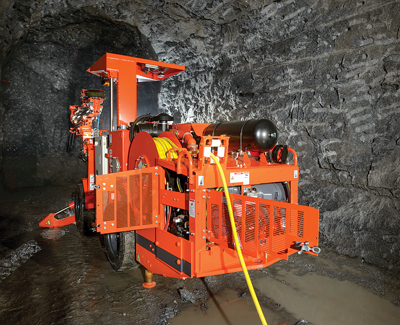 Sandvik’s DD210 single-boom development rig for narrow veins.
Sandvik’s DD210 single-boom development rig for narrow veins.As the Polish underground mining-equipment company, MineMaster, pointed out to E&MJ, the fundamental question raised by narrow-vein mining centers on whether it is better to use selective mining with dedicated small machines with limited productivity, or to make headings wider and achieve higher productivity, albeit at the expense of producing extra waste rock.
Having wider headings allows the use of standard development and long-hole rigs, and higher-capacity LHDs. However, the higher tonnage produced then needs a higher-throughout transport system, mill and recovery plant. By contrast, selective mining requires lower downstream system capacities, right through to tailings storage, although the sheer lack of space in the underground workings means that only dedicated machines can be used.
The tight space presents a lot of challenges to equipment suppliers, MineMaster said, especially in terms of providing good reliability, safety and productivity in a limited area.
RISING TO THE CHALLENGE
MineMaster has taken up the challenge and designed a new-concept narrow-vein drilling rig, which, it claims, offers much greater versatility since it can drill both face and production holes. The Face Master 2.5 NVDR single-boom drill rig is one of two new machines that the company has begun testing at an underground mine in Western Australia. MineMaster announced earlier this year its intention to enter the Australian equipment market.
Capable of working in drifts more than 2.5 m (8 ft 3 in.) high, the rig has a diesel-powered articulated chassis with permanent four-wheel drive. Its boom is fitted with a heavy-duty two-axial rotary actuator, which simplifies changing the boom position from horizontal to vertical even within the constraints of a tight heading.
The company noted that while a narrow machine may have stability problems during tramming and drilling, this can be solved using concepts already proved on low-profile rigs. Central oscillation on the carrier can help change the tire load distribution and increase stability during tramming. Conversely, drilling needs the stiffness provided by a rigid chassis, so it has designed a new automated articulation lock that converts the carrier into a rigid module while the machine is drilling.
Powered by a Deutz engine, the Face Master 2.5 weighs 13.3 metric tons (mt), is 10.2 m (33 ft 6 in.) long and 1.3 m (4 ft 3 in.) wide. It has a hydrostatic drive that can handle gradients of up to 14º. Equipped with a Montabert HC109 rock drill, it has a face coverage of 25 m2, which can be increased to 30 m2 with manual override. The boom has 360° rollover in both planes, making bit replacement safer from the operating position, which itself has a FOPS/ROPS canopy with a lifting segment for better visibility during vertical drilling.
SMALL POWER PACKAGE FROM PAUS
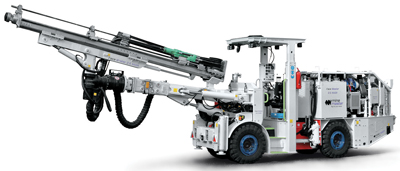 The Face Master 2.5 NVDR, currently in mine trials.
The Face Master 2.5 NVDR, currently in mine trials.Paus told E&MJ that its PFL 8 mini-LHD sets new standards in productivity, performance and agility. With an empty weight of 5.3 mt, a payload of 1.8 mt and a bucket volume of up to 0.8 m3, the machine is designed to work in extreme conditions, even at high altitude, Paus added.
The machine’s 69-kW air-cooled Deutz diesel has low fuel consumption with reduced exhaust emissions, while the bucket geometry and Z-kinematics give faster bucket filling and dumping times, as well as higher machine efficiency, according to Paus. Speed and traction are automatically adjusted to current demands by the company’s Power Drive system, which is designed to minimize tire and brake wear, and hence cut operating and maintenance costs.
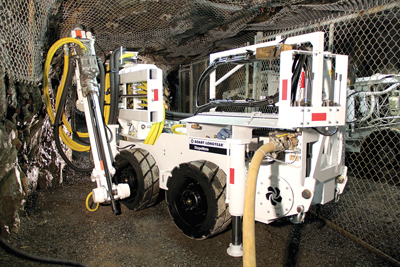 Boart Longyear’s StopeMate can be broken down for easier access.
Boart Longyear’s StopeMate can be broken down for easier access.Paus said the hydraulic drive gives good digging and tramming performance, even where haul distances are short with regular reversing. The operator benefits from joystick controls, with clearly arranged, accessible information. The PFL 8 has a ROPS/FOPS tested cabin, Posi Stop brake system and an integrated deadman’s switch in the operator’s door.
Machine electrics run through a Canbus system that includes a fault-detection display in the cab, and also means that the number of cable connections has been minimized—helping to reduce the number of potential fault sources.
Paus noted that it specializes in producing customized machines to meet the needs of individual applications, with the PFL 8 available with different buckets, an optional quick-change system for fork arms, crane hooks or a work basket, and with electric power.
COMPACT PRODUCTION DRILLS
Boart Longyear’s StopeMate and StopeMaster rigs are designed for narrow-vein mining, offering superior access, mobility, flexibility and productivity in tight-access locations, the company said. The StopeMate is equipped with a pneumatic rock drill, while the StopeMaster relies on a hydraulic rock drill for production.
Because safety is always a top priority, the StopeMate and StopeMaster rigs are equipped with heavy-duty hoses to protect the driller from hose rupture, and guarding for protection from moving parts. Removing the operators from the immediate drilling area, the rigs can be controlled with a remote positioning system up to 25 m (82 ft) away. The StopeMaster also comes equipped with an emergency stop circuit to cut the power to the drill if required.
Both the StopeMate and StopeMaster are equipped with 360° rotation for greater flexibility. With a rotating/pivoting traverse, the StopeMate is better suited for drilling smaller holes, being designed for compact drilling applications in captive stopes at depths of 12–15 m (40–50 ft). This configuration ensures precision drilling in both parallel and straight applications, and accurate operator control in drop-raise, cable-bolting, fan-drilling and parallel-drilling applications.
Designed for bulk mining applications, the larger StopeMaster is capable of drilling 64- to 106-mm-diameter holes at up to 35-m (115-ft) depths. The final drive on both rigs can be disengaged in order to facilitate towing where required.
BATTERY LOADER DUE SOON
The French equipment company, Aramine, told E&MJ it has recently developed some new options for its narrow-vein range. These include a radio remote-control system, an ejector bucket that can help save time and increase productivity when sticky rock is being handled, and a new operator’s cab door that can open in much tighter spaces than traditional designs.
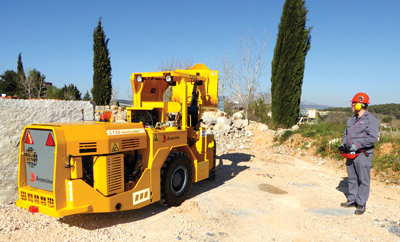 Testing Aramine’s new radio remote-control system.
Testing Aramine’s new radio remote-control system.The ejector bucket is available as an option for the company’s L110E, L130E, L130D and L150D loaders. Controlled from the driver’s seat, the mechanism is operated by a powerful hydraulic cylinder mounted within the bucket. Advantages include the ability to dump both higher and lower while keeping the bucket level, while even allowing selective dumping of the bucket’s contents.
The Z-Door, which is now fitted as standard on the L150D loader, and is available as an option on other models, provides a solution to the problem of opening the operator’s cab door in a narrow heading by hinging parallel to the loader body.
Aramine stated that its most recent development, the radio remote-control, is simple to install, with customers having the option of making use of their own transmitter and receiver. In-built safety features include the machine stopping immediately if the transmitter unit is dropped or if signals become corrupted for any reason, while the operator can also pre-set individual parameters such as the machine’s maximum tramming speed.
Aramine is now working on a new range of battery-powered loaders that it is aiming to launch in 2016. Using concepts inspired by the electric power technologies of today’s Formula 1 racing cars, the prototype will be tested in an underground mine in France at the end of this year.
A new, unique battery unit will allow the loader to run for up to three hours before recharging. Each machine will carry two fully sealed 90 V battery packs, each with its own integral charger. Recharging will take four hours from a 220V or 440V supply, while the batteries can be changed over in less than 15 minutes.
Advantages for the new system include there being no need for a separate transmission, less noise and much lower emissions, helping to cut ventilation costs, Aramine said.
NARROW AND LOW
The ST2G is the smallest, narrowest loader in Atlas Copco’s range, with a maximum width of a little more than 1.7 m (5 ft 7 in.) and a 4-mt-tramming capacity. One step up is the ST7 loader, which is 500 mm wider than the ST2G but offers close to double the carrying capacity. The company claims that these machines are equipped with some impressive features as standard, including traction control, machine protection and onboard machine diagnostics with logging. In terms of options, a cabin with climate control, load weighing and automatic lubrication are the most commonly selected.
For low-seam mining, the ST7LP has a maximum height of 1.4 m (4 ft 5 in.), which means that it can operate in areas with back heights as low as 1.6 m. This makes it very attractive for the South African platinum market, the company noted. The ST7LP has the same features as the ST7, with the latest upgrade now providing a closed cab with climate control.
Atlas Copco’s narrow-vein range of drill rigs runs from manual drilling to drill rigs with operator-assisted drill-plan handling. The rigs can be equipped with a FOPS-approved air-conditioned cab, and can carry up to a 22-kW rock drill.
The Boomer T1 D is the narrowest rig in the range at just 1.3 m (4 ft 3 in.) wide, yet offers a face coverage area of up to 23 m2. A multipurpose rig is widely used for face drilling and infrastructure work, and can also be equipped with a longhole drilling kit for production drilling.
For low-seam mining, Atlas Copco offers the Boomer M1 L and the Boomer S1 L, with heights of 1.8 m and 1.3 m (6 ft and 4 ft 3 in.), respectively. The company told E&MJ that all of these models are robust, easy to service and maintain, and can be equipped with smart options like a boom-dampening system and telescopic feeds.
MECHANIZING NARROW-VEIN BOLTING
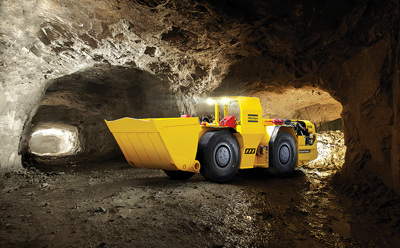 The ST2G may be small, but has a 4-mt payload.
The ST2G may be small, but has a 4-mt payload.Working from its long-term experience with bolting machines for underground coal mining, J.H. Fletcher is now also focusing on systems to improve safety and reduce the physicality involved in typical narrow-vein operations. Its answer has been a diesel-driven, electric-drilling rig that has a single boom with a mounted lifting operator platform.
Designed for use in headings from 2.4 m (8 ft) wide, the machine has been successfully introduced to gold, pgm and nickel operations, for installing both roof support and side support in narrow headings and stopes in steeply dipping formations. The drill unit can reach a maximum height of 4.4 m (14 ft 6 in.), which eliminates the need for stope backfilling before roof support can be installed. With an articulating chassis, the machine can negotiate turns with as little as 2.5 m (8 ft 3 in.) inside radius. Basket swing allows parallel offset, and also aids in maneuvering around tight corners, the company stated.
On the Fletcher machine, drilling, resin insertion and bolting can all be done from the boom-mounted operator’s basket, which both lifts and swings to allow multiple installations. Canopies protect the operator in both driving and basket-work positions, while access to the cab and drill platform along both sides of the machine allows the operator to choose the best position for the machine in the heading.
A mesh-handling assembly on the mast allows the machine to lift and position roof mesh into position, with mesh panels up to 12 ft long by 4 ft wide (3.7×1.2 m) having been placed on heading backs and sides. The operator can then bolt the mesh into place without leaving the machine, Fletcher explained.
SANDVIK OFFERS AN ELECTRIC OPTION
 Fletcher’s roof-support rig is designed to make narrow-vein mining safer, with less physical input for the operators.
Fletcher’s roof-support rig is designed to make narrow-vein mining safer, with less physical input for the operators.In July, Sandvik launched the LH204E, 4.5-mt electric loader designed for narrow-vein underground mining applications. This followed the diesel-powered LH204, which appeared in April last year and was developed initially for the Chinese market. The company has since made it available worldwide.
The company stated that the LH204E is highly maneuverable for operating in confined narrow-vein mining applications, and can handle higher payloads than similar-sized units on the market. “Sandvik Mining has worked closely with our customers to develop this loader to address the challenging operating conditions of narrow-vein underground mining,” said Sara Thorley, Sandvik’s product line manager for loading and hauling.
Meanwhile, the LH204, which has a 4-mt capacity, was launched with an improved powertrain, a higher-horsepower engine and a more powerful transmission, giving higher loading penetration rates. “The increased payload capacity results in a productivity increase of at least 13% compared with other LHDs in this size class,” said Mika Pöyri, Sandvik’s mining product manager, at the time.
When it comes to drilling, Sandvik told E&MJ that the compact size of its 200-class underground drills is well-matched for narrow-vein mining, handling development cross-sections from 4 m2 to 26 m2, and for long-hole drilling in sublevel stoping areas.
With a machine width of just 1.3 m (4 ft 3 in.), the company’s DD210 and DD211 compact development drilling rigs are suitable for working in drifts 2 m (6 ft 6 in.) wide or more. The rigs are equipped with Sandvik’s RD314 high-frequency rock drill, while their telescopic drill feed offers versatility for development, bolting or short-hole production drilling.
For production drilling, the DL210 and DL230 compact long-hole rigs are 1.5 m (5 ft) wide, and are also designed to work in drifts at least 2 m wide. Uses include production drilling, and installing cable holes and other service holes in narrow-vein sublevel stoping. The standard rock drill, the Sandvik HLX5, delivers 20 kW of output percussive power, and can handle hole diameters ranging from 51 mm to 76 mm.
The DL210 has a stable carrier and sturdy boom, and with 360° feed rotation, it offers precise feed positioning and accurate drilling up to around 20 m (66 ft) depth, while providing large fan and parallel drilling coverage, according to Sandvik.
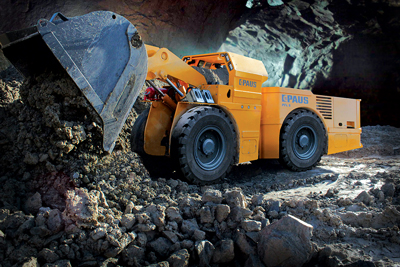 Paus has designed its PFL 8 LHD for working in extreme conditions.
Paus has designed its PFL 8 LHD for working in extreme conditions.The company provided an example of its DD210 rigs in use at Cia. Minera Lincuna’s Lincuna lead-zinc mine in the high Andes of Peru. Here, six machines are used for development in a cut-and-fill operation, producing some 400 m of heading advance per month in 3 × 3-m drifts.
NARROW-VEIN UTILITY VEHICLES
Established in 1979, and part of the Timberland group since 1997, Canadian company Marcotte Mining Machinery Services specializes in underground utility vehicles, based on the Minejack carrier. Using its M40 model as a basis, Marcotte has reduced the carrier size to an M30 style for narrow-vein applications, while keeping the reliability and safety features of the full-size carrier. The M30 is available for most of its underground utility vehicle styles, including scissor lifts, crane trucks, ANFO loaders, personnel carriers, flatbed carriers, and fuel and lube trucks.
The M30 carrier can be powered by Deutz, Cummins or Mercedes engines, with a standard shift transmission and Dana front and rear axles. Either solid or pneumatic tires can be fitted.
Standard features on the ANFO loader include a 500-lb-capacity pot feeding a single loading system. Face access is provided by a Marcotte MB150 man-basket, while additional stability is provided by two jacks at the rear of the vehicle.
 Drilling with a Brokk 400D replaces handheld work.
Drilling with a Brokk 400D replaces handheld work.The scissor-lift version carries a 1.8 × 2.7-m (6 × 9-ft) fixed deck with solid handrails and a 910-kg (2,000-lb) lifting capacity, the deck top being able to reach a height of 4.3 m (14 ft 2 in.). Both front and rear jacks provide stability while the deck is raised.
The M30 Ramcrane is equipped with a Fassi short-column crane with remote control, covering a 1.8 × 4-m (6 × 13-ft) deck without wheel wells. Tie-down straps are also provided as standard for load restraint. Meanwhile, the personnel carrier version can carry up to 12 passengers in seat-belt equipped bench seating, with options including individual seating, a ROPS/FOPS canopy or enclosed cab, and air conditioning or heating for the cab.
BROKK OFFERS A DIFFERENT APPROACH
Offering an “outside-the-box” solution for narrow-vein excavation, the Swedish manufacturer of specialist demolition machines, Brokk, told E&MJ that its equipment can undertake a much wider range of functions than just using a hydraulic hammer. Other options include fitting a rock-drill boom, a loading bucket, a grab arm or a shotcreting system, while the hammer approach to scaling and oversize rock-breaking has big advantages in terms of workforce safety. There is even the possibility of using a rotary cutting head in soft-rock deposits. A key point is that all of the tools can be operated from the same remote control box, Brokk pointed out.
For face drilling, Brokk rigs can work in places that are inaccessible to bigger machines, replacing handheld drills or small jumbos. Hole diameter capabilities range from 32 mm to 100 mm depending on the machine model, with little setup time needed.
These machines are also capable of working in low-height, dipping stopes, such as in the South African gold and platinum industry. Using a drill-equipped Brokk rig allows handheld drilling to be replaced, with the drill boom capable of drilling to specific patterns and hole orientations, even when working on steep dips. Not only is this safer, but holes can be drilled deeper and with larger diameters.
For tunnel rehabilitation, the remote-control system allows the operator to remain away from potential hazards, while the machine can be equipped to muck out debris as well as remove loose rock from the back and sidewalls.









